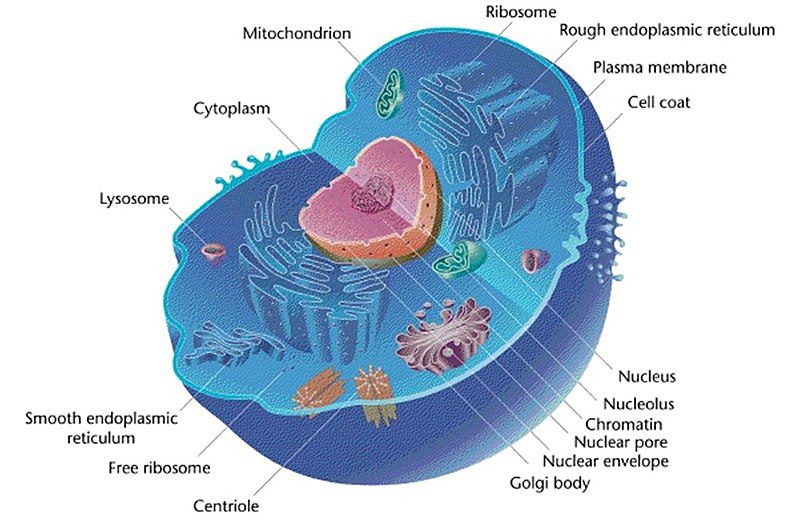What is the cytoplasm?
The cytoplasm is the part of the protoplasm which is placed between the plasma membrane and the nucleus (or nuclear zone in the prokaryotic cell). It is a dense, semitransparent, elastic, and aqueous mixture. The cytoplasm contains over 80% water, to form the liquid portion named cytosol. This is also called hyaloplasm, and observed under the optic microscope it looks like a uniform, structureless mixture. It contains a large number of molecules, such as enzymes and other proteins, which represent 20-30% of the total, carbohydrates, lipids, and other compounds with low molecular weight. It also contains inorganic ions; their concentration is higher here than in the cytoplasm and other substrates.
During the preparation for the observation under the microscope, the proteins in the cytosol collapse and aggregate, forming structural artifacts. This represents one of the most relevant complications that made it difficult to understand its structure.
The cytosol is the place where the reactions of the cell metabolism take place; thus, it has an organized structure with proteins bound to fibers or localized in specific regions.
With some differences, it is possible to find it both in eukaryotic and prokaryotic cells.
Cytoplasm in the prokaryotic cells…
In prokaryotic cells, the cytoplasm is composed of the material contained in the cell membrane, in which are immersed the nuclear zone (nucleoid), the ribosomes, and the inclusions. Also, the enzymes are immersed in the cytosol, and in the eukaryotic cell they are included in the cellular organelles. The cytoplasm in the prokaryotic cells has a very simple structure compared to the cytoplasm in the eukaryotic cells since the latest also presents the cytoskeleton and the cytoplasmatic flow (Fig.1).

… and in the eukaryotic cells
In the eukaryotic cell, there are a lot of different cell organelles (Golgi apparatus, mitochondria, etc) and the nucleus. Moreover, the characteristic that makes it possible to distinguish between the prokaryotic and the eukaryotic cell is the cytoskeleton (Fig. 2).

The cytoskeleton is a thick net made by proteic fibers that, as a net of streets and highways, allows the movement of substances and organelles inside the cell and the motion of the cell itself.
The fibers that constitute the cytoskeleton can be divided into microfilaments (actin) and microtubules (tubulin). They are formed by two globular protein subunits which associated with themselves quickly and reversibly. The interweaving between these fibers makes a three-dimensional frame suitable for maintaining the structure of the cell. Microfilaments and microtubules are called intermediate-size filaments, and their quantity and ratio can be variable. These fibers can be formed by one single kind of protein or by an association of proteins, as desmin, vimentin, actin. They give mechanical support to the cell and establish the position of the cell organelles.
Moreover, the protein fibers are linked to thin protein filaments which form the micro trabecular grid, another tridimensional protein web.
The cell movement is generated by the interaction between the protein filaments of the cytoskeleton and its additional proteins. The latest varies based on the type of the cell; for instance, the movement of cilia and flagella strictly relates to the microtubules. Muscle contraction, on the other hand, depends on the microfilaments.
The movement of cell organelles in the cytoplasm is due to the interaction of the microtubules, the intermediate filaments, and specific proteins, like kinesin and dynein. Thanks to these associations, the organelles move on the proteic filaments like they are on the rail.
The cytoplasmic flow, or streaming, consists of the movement of the cytoplasm inside the cell; this motion is important to simplify the distribution of nutrients, but also to support the movement of the cell on a surface.
Original article: “Citoplasma” by Vanessa_Vitali
Bibliography
- http://www.treccani.it/enciclopedia/citoplasma/
- https://books.google.it/books?hl=it&lr=&id=g4i-LFx2oMIC&oi=fnd&pg=PR13&dq=flagelli+e+fimbrie&ots=viHp0FV5Y_&sig=FUMfPH_VwSmFJa2u3h9ZFJJVatI&redir_esc=y#v=onepage&q=flagelli%20e%20fimbrie&f=false
- http://www.treccani.it/enciclopedia/ialoplasma_%28Dizionario-di-Medicina%29/
Pictures bibliography
- https://courses.lumenlearning.com/microbiology/chapter/unique-characteristics-of-prokaryotic-cells/
- https://commons.wikimedia.org/wiki/File:Eukaryotic_Cell_(animal).jpg
- https://slidetodoc.com/cytoplasm-what-is-cytoplasm-and-how-does-it/